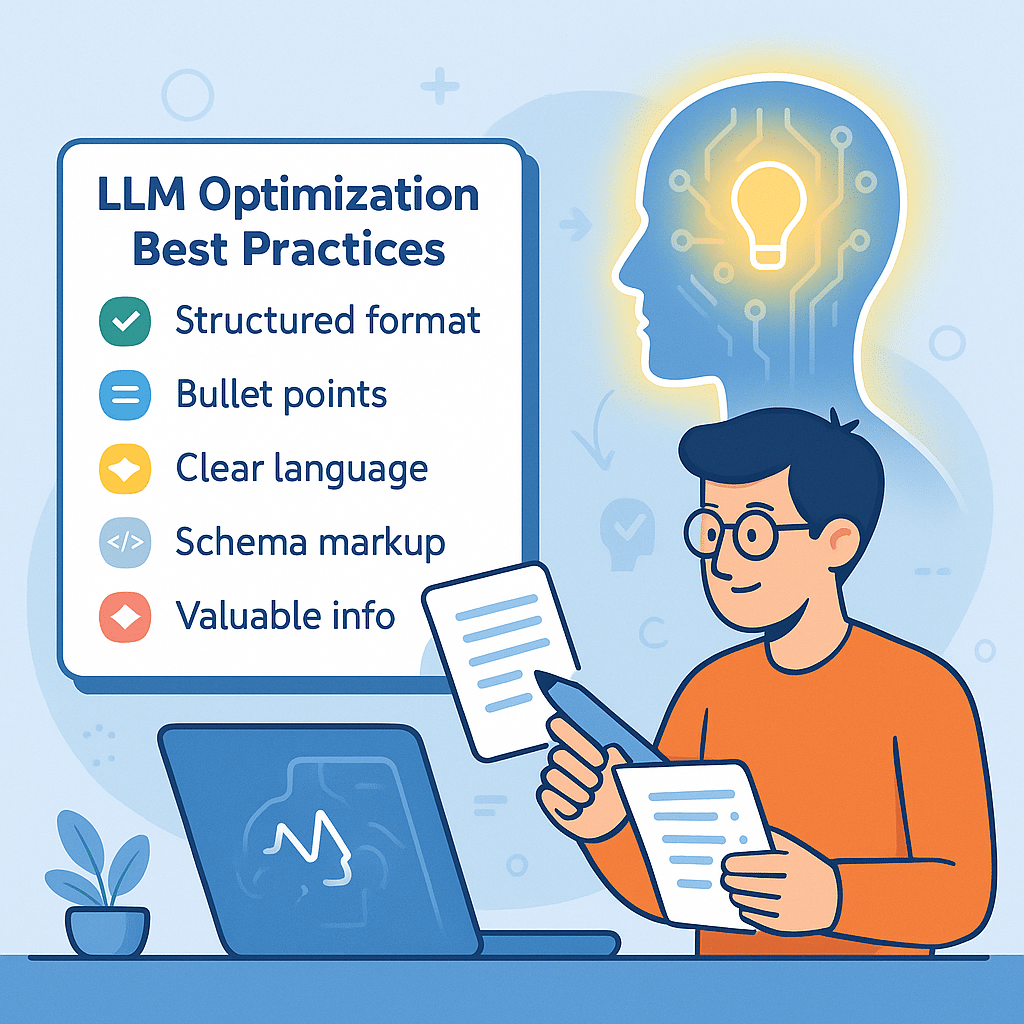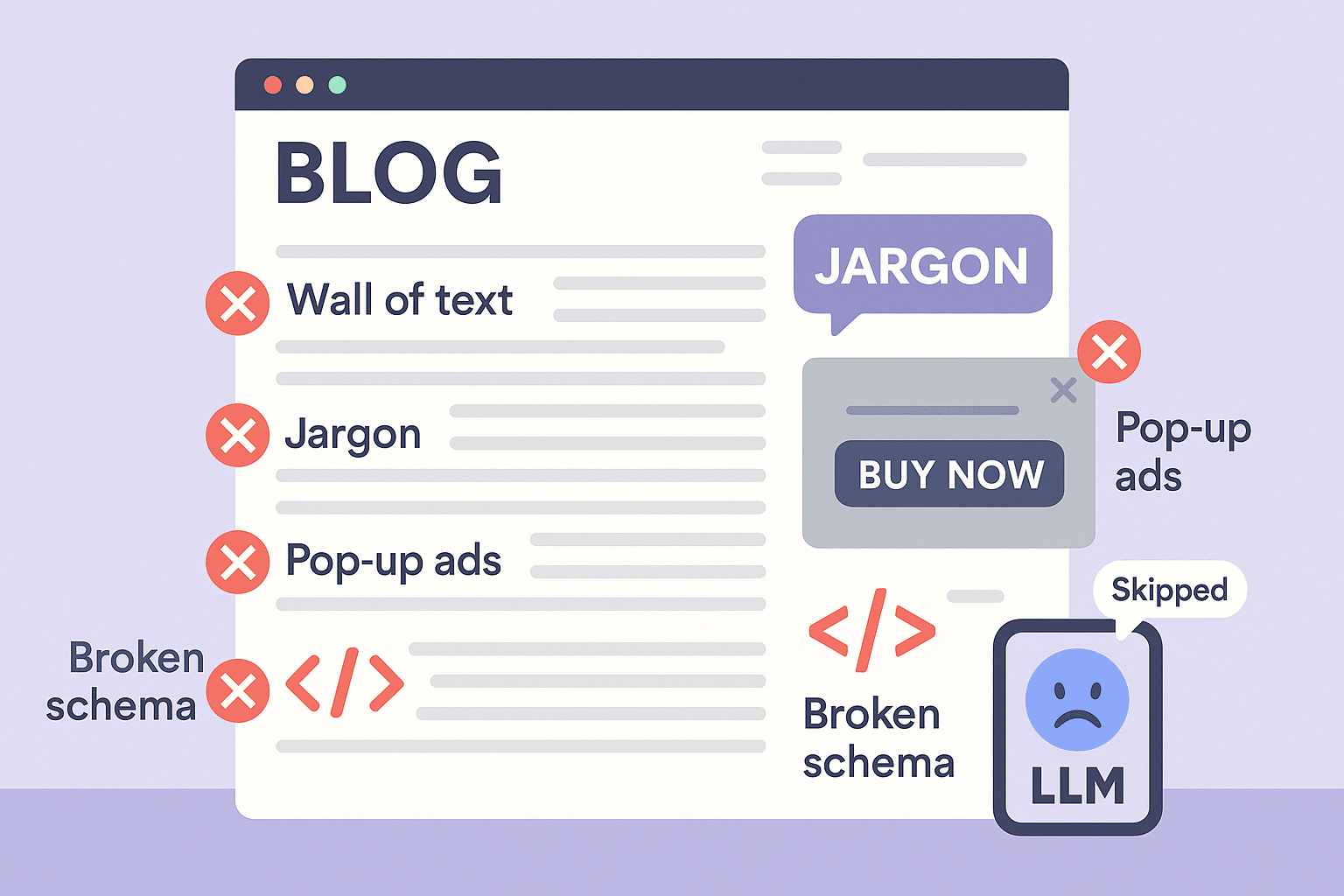Top Content Formats for LLMs: Enhance AI Engagement and Performance
Why LLM-Optimized Content Matters

Large Language Models (LLMs) like ChatGPT, Claude, and Google’s AI Overviews are transforming how people find and interact with content online. Unlike traditional search engines that point users to a list of links, LLMs often generate direct answers, summaries, and even opinions—without needing the user to click through to a website.
That means the format and structure of your content now play a huge role in LLM visibility. If your content is not easy to parse, summarize, or interpret, it may not appear in AI-generated results—even if it ranks high in regular search engines.
So how do you structure content that’s optimized for LLMs? In this guide, we’ll explore 7 high-performing content formats that help improve your visibility in language model outputs, boost engagement, and future-proof your SEO strategy.
Principles for Creating Effective Content
Creating LLM-friendly content involves using structured formats, such as headings, bullet points, and short paragraphs, to make content easily parsed and understood by language models.
Content should be optimized for AI search by incorporating relevant keywords, meta descriptions, and optimizing images, while avoiding common mistakes like keyword stuffing and poor heading structure.
The use of clear and concise language, avoiding jargon and technical terms, is essential for ensuring that content is accessible to both human readers and LLMs, and that it can be easily summarized and featured in AI overviews.
Content creators should focus on providing valuable and relevant information, using formats like step-by-step guides, comparison posts, and lists, to increase the chances of being featured in LLM outputs and AI summaries.

7 Content Formats for LLMs Visibility
LLM-friendly content formats include blog posts, articles, and guides that are well-structured, easy to read, and provide valuable information, using formats like JSON-LD and XML to enhance machine readability.
Using structured data, such as schema markup, can help LLMs understand the context and relevance of content, increasing its visibility in search results and AI overviews.
Content creators should experiment with different formats, such as multimodal content, virtual assistants, and voice-activated devices, to reach a wider audience and improve LLM performance.
1. Structured List Posts (Listicles)
Why it works: List-style posts are one of the easiest content formats for LLMs to interpret and summarize. They break down complex information into digestible chunks and naturally lend themselves to direct answers.
Examples:
“10 Best Tools for AI Writing”
“7 Reasons Your Website Needs Structured Data”
“5 Ways to Improve LLM Performance in Content Creation”
These are often picked up by LLMs for direct answers or “featured snippet” style results in platforms like Google’s AI Overviews.
Tips
2. Step-by-Step Guides and Tutorials
LLMs are frequently used to solve problems, so guides that walk users through a process are highly useful.
Whether you're teaching users how to set up a product, run a report, or write an AI prompt, make sure each step is clearly marked and easy to follow.
Structure Example:
How to Set Up Google Search Console:
1. Sign in with your Google account 2. Add your website property 3. Verify site ownership 4. Submit your sitemap
LLMs like ChatGPT can easily turn this into a summarized answer or instructional output.
Best Practices
3. FAQs and Q&A Content
Q&A formats are tailor-made for LLMs because they resemble the exact structure of how users query these models.
You can include:
- A full FAQ page on your website
- An FAQ section at the bottom of blog posts
- Individual blog posts that answer a single question in depth
Example:
Q: What is Retrieval Augmented Generation (RAG)?
A: RAG is a machine learning method where a model retrieves external documents to improve the quality of its generated answers.
LLMs often pull Q&A sections directly into AI summaries or use them to train natural language generation outputs.
4. Comparison Tables and Side-by-Side Analysis
Comparison tables help users (and LLMs) quickly evaluate options. Whether you’re comparing tools, products, or pricing, a well-structured table allows LLMs to extract information quickly.
Example:
Feature | Tool A | Tool B |
|---|---|---|
Price | $19/month | $25/month |
Free Trial | Yes | No |
LLM Integration | Yes (ChatGPT) | Yes (Gemini) |
Tips
5. Schema-Enhanced Blog Posts (with JSON-LD)

LLMs are trained on structured data formats like JSON-LD, making it easier for them to understand articles that use schema markup.
Common types of schema you should use:
- Article schema
- FAQ schema
- How-To schema
- Product schema
This structured metadata helps LLMs understand the context and purpose of your page, which improves its chances of being selected for AI summaries or search results.
6. “What Is” and Definition Content
One of the most common prompts to LLMs starts with “What is…” or “Explain…”
If your content answers basic definitions—especially using clear subheadings and plain language—you’re more likely to be included in responses from tools like ChatGPT, Perplexity, or Google AI.
Use bold keywords, relevant internal links, and real-world examples to boost both readability and relevance.
7. Multi-Format or Multimodal Content (Text + Media)
As LLMs evolve, they’re becoming better at interpreting multimodal inputs—meaning they can understand and combine text, images, code, and audio.
If your content includes diagrams, infographics, audio explainers, or embedded videos, you increase your visibility on platforms that support multimodal AI outputs (like GPT-4o or Sora by OpenAI).
Examples:
- Code snippets in tutorials
- YouTube videos embedded in blog posts
- Infographics with alt-text descriptions
Pro Tip: Always add descriptive alt text for images. LLMs use alt text to understand what the image represents.

Common Mistakes to Avoid
Bonus: Tools to Audit and Improve LLM Content Readiness
Here are some free and paid tools to help you create content that's more LLM-optimized:
✅ Google Search Console – check indexing and structured data
✅ Surfer SEO – optimize content for search and AI
✅ Yoast SEO – help with schema and content structure
✅ Schema Markup Validator – validate your JSON-LD code
✅ ChatGPT – test how your content is interpreted
Key Takeaways: Make LLMs Work For You
Tip | Why It Matters |
|---|---|
Use listicles and bullet points | Easy to summarize and extract |
Write FAQs and definitions | Match natural language queries |
Add schema and structured data | Improves machine readability |
Include comparison tables | Helps users and AI evaluate quickly |
Use multimodal elements | Enhances engagement and expands reach |
Avoid formatting errors | Prevents content from being skipped by AI |
![ChatGPT Image Jul 29, 2025, 03_28_44 PM An infographic-style layout summarizing the article’s key takeaways: listicles, FAQs, schema, tables, multimedia. Each tip is shown flowing into an LLM’s glowing output bubble.
] make in a square format](https://www.misaias.com/wp-content/uploads/2025/07/ChatGPT-Image-Jul-29-2025-03_28_44-PM.png)
Final Thoughts: Future-Proofing Content for the Age of AI
Content formats for LLMs aren't just a technical upgrade—they represent a new era of content strategy. As platforms like ChatGPT, Google Gemini, and Perplexity shape the way people access information, the structure and clarity of your content become just as important as the message itself.
By using the 7 formats we’ve covered, you can:
Improve your chances of being referenced or summarized by AI tools
Deliver faster, clearer answers to readers
Boost visibility across both traditional and AI-powered platforms
And as the capabilities of generative AI continue to grow, content that is well-structured, clear, and optimized for LLM readability will win out.
